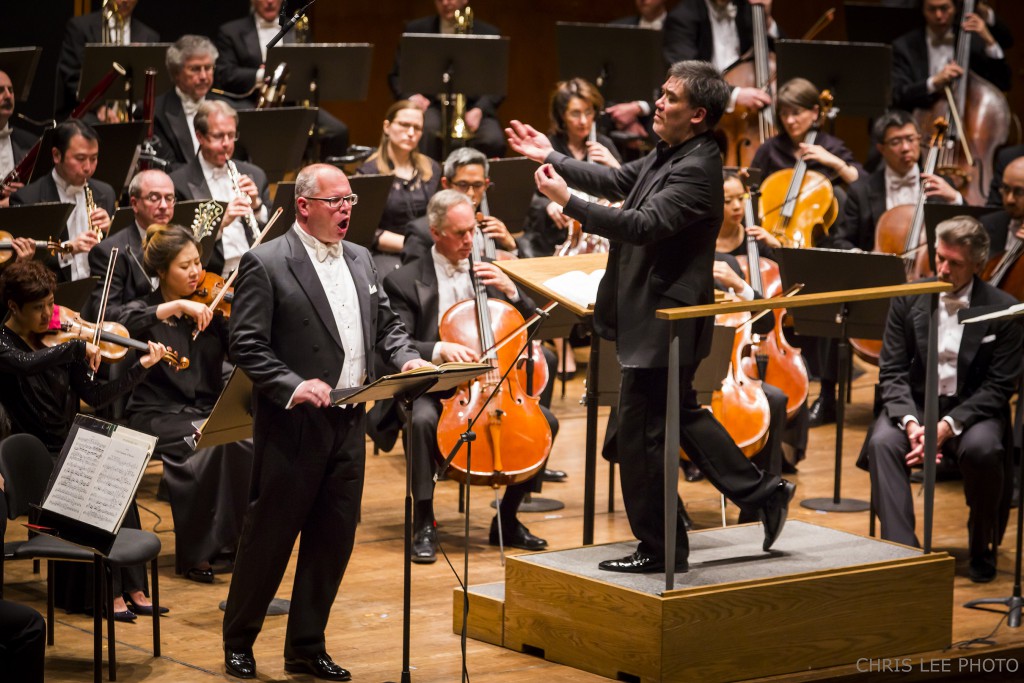Gilbert, Philharmonic find cosmic balance with Mahler, Sibelius

Alan Gilbert conducts the New York Philharmonic in Mahler’s Das Lied von der Erde” with soloists Thomas Hampson and Stefan Vinke. Photo: Chris Lee
Shortly after the premiere of his Symphony No. 3, Jean Sibelius met Gustav Mahler in Helsinki. Sibelius later told his biographer Karl Ekman that the two men argued over their conception of symphonic form. “I maintained,” Sibelius reported, “that I admired its strictness and the profound logic that creates an inner connection between all the motifs.” Mahler, on the other hand, said “the symphony must be like the world. It must contain everything.”
Considering their importance, proximity, and how their views encompass the entire symphonic tradition, it would only be natural to find them together on the same concert program. But when does this actually happen? Wednesday night, for one—the New York Philharmonic opened a short subscription series with Sibelius and Mahler together, for the first time in some concertgoers’ experience.
The juxtaposition and pairing of Sibelius’ Symphony No. 7 and Das Lied Von Der Erde from Mahler is immediate; two later masterpieces that distill each composer’s art and are full of mystery. With Alan Gilbert conducting, and tenor Stefan Vinke and baritone Thomas Hampson singing the Mahler, the music-making was skillful, beautiful, and deeply moving.
Despite their symphonic size and duration—especially *Das Lied*—these are both profoundly intimate works. Because his is disguised as absolute music, Sibelius has a more universal reach, churning up powerful, unnamed things for the listener to ponder. Mahler, being Mahler, is intimate about himself, narrating thoughts about life and death through his music and the words of Tang Dynasty poet Li Po, as translated and rewritten by Hans Bethge and the composer.
Das Lied is expansive, exploding with details and variations. But the Symphony No. 7 is no less so. Sibelius’ route is the infinite possibilities between two points of a closed, short journey, the type of internal reverie that feels timeless while one transits the musical space from A minor to its relative C major.
In one movement (divided into four continuous sections that define standard form), Sibelius effects a flowing cascade of syncopated, conflicting pulses, phrases that never seem to resolve but are overtaken by the start of the next unstable harmonies, amid orchestration that moves colors in and out and around and under. Even when it is slow, it is mercurial, always one step ahead.
Gilbert scrupulously managed all the tempo modulations, which enhanced the scudding, elusive quality of Sibelius. It also produced a thrilling feeling of accumulating mass and momentum, leading up to the two climatic trombone solos, played with a rich, plangent sound by Joseph Alessi, blended ideally with the orchestra. These serve like the towers on a suspension bridge, points past which the journey is fully committed and at which resolution is in site.
But the resolution is deceptive. The final C major chord arrives in a perfect cadence, but the orchestra had played with such intensity, had been so committed to the turbulent beauty of the music, that the final chord had the exact right weight and sense of instability—as it if was a jumping off point to further journeys. This was an ideal performance of this great symphony, and as with their previous playing this year, the orchestra produced an absolutely gorgeous, resonant Sibelius sound.
Das Lied was played very differently, and the results were just as wonderful, heard here in the rarely performed version for tenor and baritone. Unusually for this piece, and Mahler in general, Gilbert guided the orchestra toward a dry sound, sinewy and slightly abrasive, like grainy, unpolished wood. The music, scored for a large orchestra and with big moments, also has more intimacy in the writing and the scoring than any other Mahler symphony, and this was a wise approach.
The style worked to mutual benefit with Vinke and Hampson. Vinke is an old-fashioned tenor on today’s landscape, less Wunderlich than Pears. Hampson has been an important Mahler singer for decades. Together, they eschewed commonplace values of beauty of sound and line for an intelligent and hauntingly expressive musicality.
Vinke, in the characterful tenor part, nearly brayed with a coarseness and wobble in the two drunkard songs, then sang with a warm lilt in “Von der Jugend.” At the most vehement points, he seemed ready to smash the music in fury and despair.
Hampson was at his plain-spoken best, close to conversational, the phrases nearly free, completely transparent to meaning, and clearly involved in all the instrumental passages. His delivery of “Die Welt schlaft ein!” in “Der Abschied” was like centuries of great poetry captured in a single breath.
As in the Sibelius, Gilbert’s attention to the letter was perfect for the spirit of the music. The rising string phrase that mirrors the voice in “Der Einsame im Herbst” was understated, almost offhand, opening up distant horizons of intimacy in the performance. And with so many individual instruments shining, principal oboist Liang Wang was particularly outstanding, playing with a deep sense of beauty in his long solo phrases, and modulating his colors when responding to the singers.
This is a unique program that offers important ideas and extraordinary experiences, and the playing was as fine as one will hear. It’s a shame that there are only two more chances to catch this.
The program will be repeated 7:30 p.m. Thursday and 11 a.m. Friday. nyphil.org
Tea Sets DoMiTea Amber Jewelry Sleeping Bag


